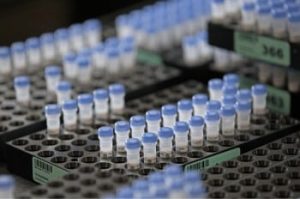Key summary:
Global concerns about infectious diseases did not end with COVID-19. Established and emerging threats continue to take their toll on global populations.
- Tuberculosis (TB) was likely the deadliest infectious disease in 2024, claiming 1.25 million.
- Infectious diseases continue to stalk vulnerable populations due to falling vaccine rates, climate change, and antimicrobial resistance.
- Integrated DNA Technologies supports infectious disease researchers with solutions such as next generation sequencing and PCR.
From HIV to fungal infections to mysterious and deadly jungle ailments, infectious diseases remain a persistent threat in many parts of the world.
In 2024, tuberculosis was likely the deadliest infectious disease, claiming an estimated 1.25 million lives. Other deadly scourges include malaria, HIV/AIDS, and influenza. Data show that while many significant strides have been made in combating some infectious diseases, they continue to pose a significant global public health challenge.
Infectious diseases remain prevalent in 2025 for a number of reasons, including declining vaccination rates, antimicrobial resistance, globalization and travel, climate change, emerging pathogens, persistent endemic disease, zoonotic spillover, and inadequate public health infrastructure.
What does 2025 hold when it comes to infectious diseases? We’ve outlined several challenges and opportunities to keep you informed.
H5N1 bird flu: A looming threat
H5N1 has been present since 1996, but this bird flu is emerging as a major concern for public health officials in 2025. There were 81 confirmed human cases globally in 2024, the most since 2015. It’s also a major concern for consumers, who are facing soaring egg prices in the U.S. and elsewhere.
The virus has been widely spread in both wild and domestic birds, and recently, it has been found infecting dairy cattle in several U.S. states and horses in Mongolia. This cross-species transmission raises concerns about the potential of the virus to adapt and spread more efficiently among humans.
Measles: Resurgence due to declining vaccination rates
Measles has made a troubling comeback, largely due to declining childhood vaccination rates and rising exemptions from school vaccine requirements. As of February 28, 2025, the CDC has reported 164 measles cases in nine states, with most being reported in Texas. This is a significant increase from previous years and is in line with falling vaccination rates, especially among children. For the 2023-24 school year, 39 states had measles, mumps, and rubella vaccination rates below the federal target.
Tuberculosis: Rising cases globally make it the world’s leading infectious disease
Tuberculosis has reclaimed its position as the world's top cause of death from a single infectious agent after having briefly fallen behind deaths due to COVID-19. With more than 10 million new TB cases annually, the disease remains heavily concentrated in a few dozen countries, including India, Indonesia, China, the Philippines, and Pakistan.
Easily preventable and curable, the persistence of TB as a major global health threat highlights the need to strengthen health systems, particularly in those high-risk countries.
HIV and AIDS: Progress and challenges
Globally, HIV and AIDS treatments continue to improve. While significant progress has been made in the global HIV response, challenges remain. Almost 31 million people received lifesaving antiretroviral therapy in 2023, which helped reduce AIDS-related deaths to their lowest levels since 2004. However, progress is uneven, and new infections continue to rise in parts of North and South America as well as Europe. New cases are falling the fastest in sub-Saharan Africa.
Key populations remain underserved by many HIV programs, with rising cases associated with poverty, lack of education, low socioeconomic status, insufficient HIV prevention investments, and lingering societal stigmas.
Malaria: A persistent public health threat
Malaria continues to pose a significant public health challenge, with an estimated 263 million new cases and 597,000 deaths in 2023. The situation has worsened since 2015, with nearly 95% of global cases and 96% of deaths occurring in 29 malaria-endemic countries. Nigeria, the Democratic Republic of the Congo, Uganda, Ethiopia, and Mozambique account for the largest share of global malaria cases and deaths.
Efforts to combat malaria must continue to focus on these high-burden countries, with a particular emphasis on strengthening health systems and addressing social determinants of health to reduce inequities and remove barriers to health services.
Emerging threats: Mpox and Congo’s mystery disease
Mpox, previously known as monkeypox, remains a concern in 2025, with ongoing outbreaks in various parts of the world, particularly in western and central Africa. The virus is proven to spread rapidly and impact diverse populations, which highlights the need for continued surveillance and preparedness.
Factors including rapid population growth, increased travel, urban populations moving into rural areas, climate change, and more continue to suggest that the next deadly infectious disease could be right around the corner. Just as COVID-19 spread around the world in a matter of months, the next pathogen could silently be emerging right under our noses. For example, a mysterious illness linked to bat consumption recently emerged in the Democratic Republic of Congo, causing significant concern among health officials. The outbreak began in January 2025 in the village of Boloko, located in the Equateur Province of northwestern Congo. Initially, it was traced to three children under the age of 5 who ate a bat carcass and all died within 48 hours. Despite testing, the exact cause remains undetermined, and most patients exhibit signs of hemorrhagic fevers, and the interval between onset and death is typically 48 hours.
Alarming trends in the global infectious disease landscape
Despite advances in medicine and population health, there are several concerning trends shaping the infectious disease landscape in 2025:
- Declining vaccination rates: Growing anti-vaccine sentiments have, particularly among school-age children, created conditions that allow for the resurgence of preventable diseases like measles.
- Climate change: Climate change is contributing to the spread of vector-borne diseases, with cases of dengue—normally found in tropical regions of the world—reported in California and Arizona in individuals with no travel history.
- Antimicrobial resistance: Antimicrobial resistance continues to grow, with cases of gonorrhea resistant to all approved antibiotics reported in Massachusetts. Other examples of antimicrobial resistance include methicillin-resistant Staphylococcus aureus, vancomycin-resistant Enterococcus, extended-spectrum beta-lactamase-producing Enterobacter ales, and multidrug-resistant Pseudomonas aeruginosa.
- Potential for immune memory loss: Large measles outbreaks could lead to higher numbers of other infections due to the way measles wipes out immune memory of other infections.
Infectious disease research at Integrated DNA Technologies
Integrated DNA Technologies (IDT) supports infectious disease research through a number tools and solutions, including:
- Real-time qPCR (RT-qPCR)
- Digital PCR (dPCR)
- Antibody-based monitoring
- Next generation sequencing (NGS)
IDT also supports large-scale viral surveillance efforts aimed at monitoring the spread of viral diseases both geographically and temporally so that researchers can identify new outbreaks of diseases. This type of surveillance, for example, was key in the development of public health guidelines throughout the SARS-CoV-2 pandemic because it allowed researchers to identify novel variants and track their spread.
Identifying and tracking new viral variants is often tough because viruses and pathogens evolve, which changes their genetic material. This means that the tools built to target or even treat that organism can become less effective. Read more about viral surveillance here.

























